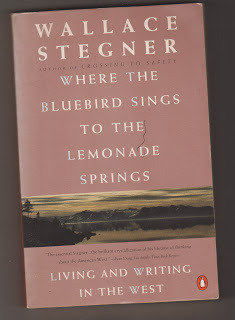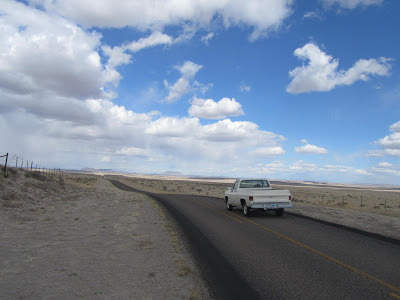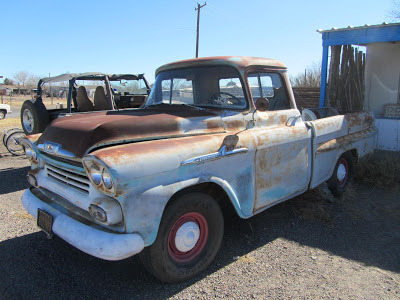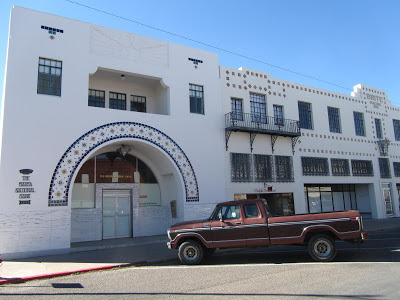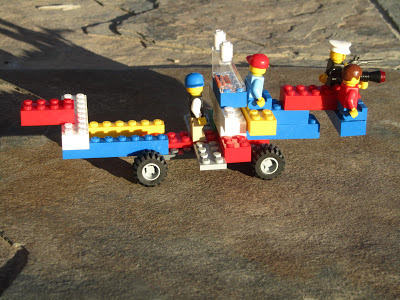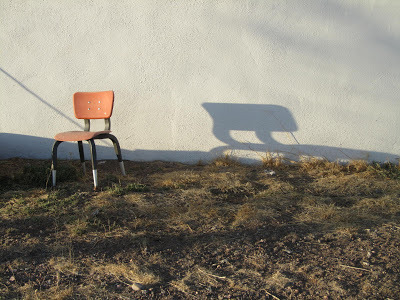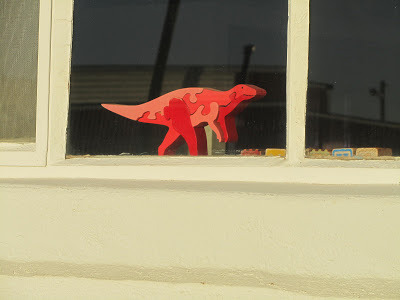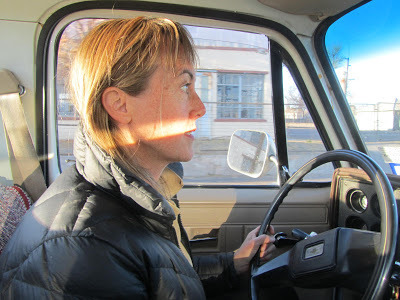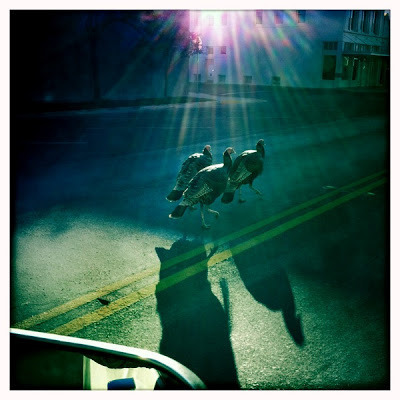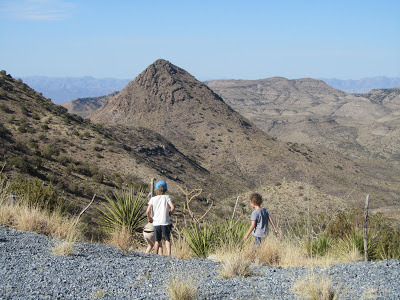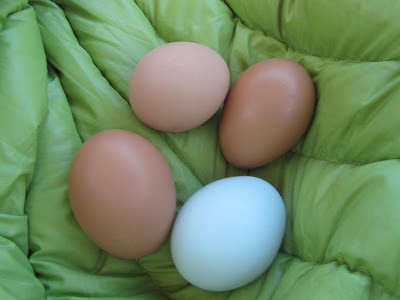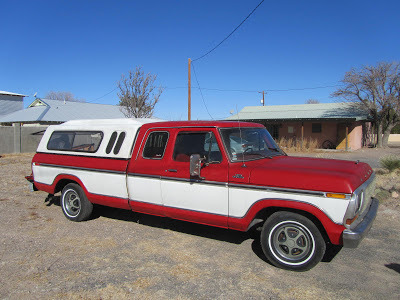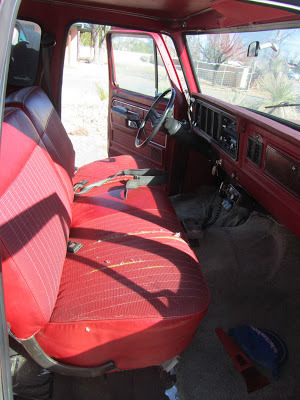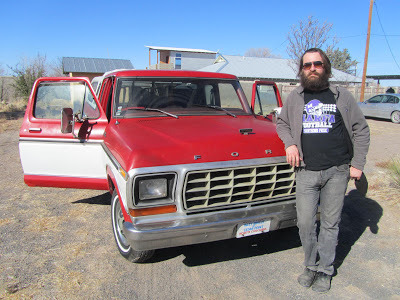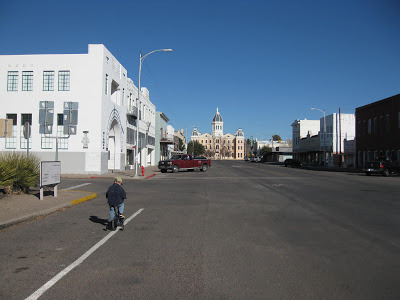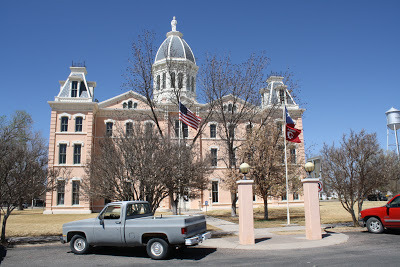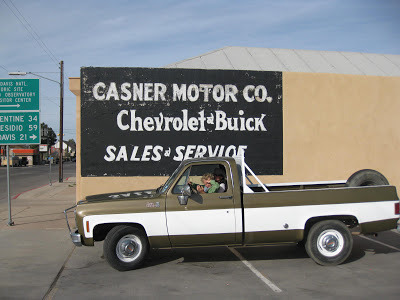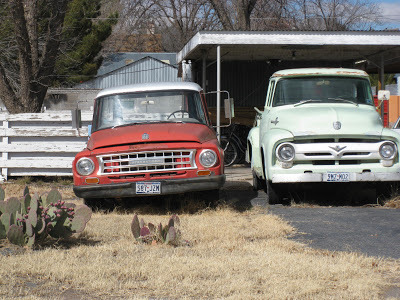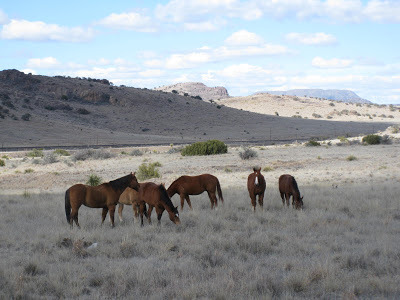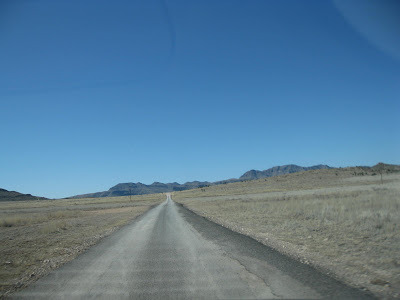Peter Behrens's Blog, page 552
December 18, 2012
re. Wallace Stegner, and the West
Published on December 18, 2012 21:55
December 16, 2012
Wallace Stegner, The National Post, and the Cross-Canada Road Trip
“Home is a notion that only nations of the homeless fully appreciate and only the uprooted comprehend.”
― Wallace Stegner, Angle of Repose
 ©Alex Emond 2012While I was a Stegner Fellow at Stanford I was lucky enough to meet the novelist and environmentalist Wallace Stegner, then in his eighties and an impressive man. Wally had just spent the morning cutting firewood. My introduction to his work was "Wolf Willow", the memoir of a boyhood spent in southern Saskatchewan. WS named the town where it was set Whitemud, but it is really Eastend, Sask.
©Alex Emond 2012While I was a Stegner Fellow at Stanford I was lucky enough to meet the novelist and environmentalist Wallace Stegner, then in his eighties and an impressive man. Wally had just spent the morning cutting firewood. My introduction to his work was "Wolf Willow", the memoir of a boyhood spent in southern Saskatchewan. WS named the town where it was set Whitemud, but it is really Eastend, Sask.
Several years back, I drove across Canada and kept a trip log for the National Post. It was published in NP under the title, "Going the Distance" and I'm posting it, below.
On that trip I slept in my car most nights, so I could wake up in the middle of nowhere. One morning, a few miles west of nowhere, I found Jack's Cafe in Stegner's town of Eastend, Saskatchewan. A few half-tons, outside, and a few ranchers inside, and the best diner food I've ever experienced. Everything fresh. They smoked their own bacon. It seems like a dream to me now...but Alex Emond took a photo last year, so Jack's still does exist. Next time you happen to be driving across the high lonesome, time it for a breakfast stop for Eastend. And bring along your copy of Wolf Willow.
In the meantime, here's my piece--''Going the Distance"--from National Post. I do not understand why the text is posting in various fonts and sizes. It is annoying and distracting, I realize, but I can't seem to do anything about it. Apologies.
 ©2012 Mary Behrens GOING THE DISTANCEI was a restless child. When I realized that all roads in North America were connected, and that going anywhere--anywhere!-- was just a matter of taking the correct sequence of turns, I wanted to step on the gas immediately.
©2012 Mary Behrens GOING THE DISTANCEI was a restless child. When I realized that all roads in North America were connected, and that going anywhere--anywhere!-- was just a matter of taking the correct sequence of turns, I wanted to step on the gas immediately.
I developed an obsession with maps, & drove across the country for the first time when I was eighteen. I've made the trip twenty times since. Now I'm piloting that indestructible symbol of middle-age, a Volvo station wagon. Flying coast-to-coast still seems like a waste of a perfectly good continent.
...
My wife likes highways but prefers frequent-flyer miles. I grew up in Montreal, live in Southern California. I'm headed home after a stay at the Fine Arts Work Center in Provincetown, Massachusetts, where I’ve been working on a novel about a boy coming out of Famine Ireland in the 1840s. It is late October and I’m invited to spend the weekend with friends at Tadoussac, Quebec. I have not been north around Lake Superior in a decade. And I miss the austere light of Saskatchewan in autumn. So I've decided to drive home across Canada....
The plan is to aim for the Queen Charlotte Islands. I can see the trip really ending there. Can't go further west in Canada. Then I'll head for California I've left it kind of late in the season, though. Anxious about snow in the mountains.
...Driving up and down the St John Valley on the Maine side, peering across the river at Canada. Small, rough hills spattered with autumn color. I feel reluctant to cross. Like a stranger standing on the porch of the house where he grew up, wary of touching the doorbell. This is disconcerting. I have never felt American. If I don't feel like I'm coming home here, crossing this border, I'm never going to.French Canadian names--Martin, Lavoie, Plourde--on all mailboxes along the last few miles of US 1. The kid at the Gulf station says the local dialect is Valley French. Across the river, "they speak more Parisian."
...
Past L'Universite de Maine á Fort-Kent I get caught in Saturday-evening-Mass traffic outside Eglise St-Louis, then finally cross the river at Edmundston. The officer at Canada Customs says Rosette's in Frenchville, Maine is the best place to eat.
...
Rosette’s is packed with families, mémère, pépère, toute la gang chowing down on broiled scallops, chowder, steaks, blueberry pie. Everyone talks fast and twangy. Sentences that start French and end English, or the other way around.
...
I'm of the Trudeaumania generation. "If you want to see me again, don't bring signs saying 'Trudeau
is a pig', and don't bring signs that 'Trudeau hustles women'
because
I won't talk to you.
I didn't get into politics to be insulted.
And don't throw wheat at me, either.
If you don't stop that,
I'll kick you right in the ass."
[PET to a young protester throwing wheat at him during a speech in Regina, (17 July 1969)]Pierre instructed us to get out there and see our country. Geography was patriotism. Maybe you remember those long lines of blackfly-baiting hitchhikers stranded out along the Trans-Canada Highway on any summer night, 1967-76?
... Sunday morning grey skies in Québec exaggerate a sense of northern bleakness. Post-Catholic countryside sports bar salons and plastic road-signs advertising danseuses, sometimes nu. The ferry from Rivière-du-Loup takes an hour and a half to cross the St. Lawrence, which is tidal and smells of the sea. Tadoussac must come close to a European fantasy of Canada. Busloads of francais de Francehave day-tripped down from Quebec City. Tiny wooden town, rough Laurentian hills, birch trees pulsing yellow.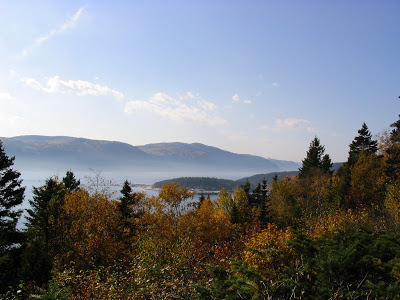 ©2012 Mary Behrens The sky over the estuary is stuffed with sunlight, the light of wide horizons.
©2012 Mary Behrens The sky over the estuary is stuffed with sunlight, the light of wide horizons.
 ©2012 Aidan O'NeillTadoussac has a population of eight hundred or so, and twenty-eight listings in the phone book under Hovington, all with francophone first names. The forebear was a British sailor. Sixty more Hovingtons are listed in Sacre-Coeur, the next village. My friend says all the Hovingtons he knows insist they are unrelated to any others. The Europeans come to see les baleines puis les autochtones. Whales and Indians. Beluga are scarce this week, but here's one.
©2012 Aidan O'NeillTadoussac has a population of eight hundred or so, and twenty-eight listings in the phone book under Hovington, all with francophone first names. The forebear was a British sailor. Sixty more Hovingtons are listed in Sacre-Coeur, the next village. My friend says all the Hovingtons he knows insist they are unrelated to any others. The Europeans come to see les baleines puis les autochtones. Whales and Indians. Beluga are scarce this week, but here's one.
 Les autochtones
are scarcer. Or don't wish to perform for the Europeans. When the busloads arrive at the Cafe du Fjord, Québecois staff fake it with buckskins and face-paint.
Les autochtones
are scarcer. Or don't wish to perform for the Europeans. When the busloads arrive at the Cafe du Fjord, Québecois staff fake it with buckskins and face-paint.
... Silver Mercedes Benz, parked beside a farm stand at the eastern tip of Ile d'Orleans. Cold wind blowing across fallow. Smell of black earth, apples. The Japanese couple, wearing Barbour waxed jackets, speak fractured English. The farm woman with the jolly red cheeks replies, in French, that, regretfully, she doesn't speak the language. Maybe her French sounds English to the Japanese, not fluent themselves, because they repeat in English, only louder. I catch the drift. They want to know if the maple syrup is local. She looks offended when I translate. "Bien sur monsieur, bien sur!" Stamping rubber boots, she gestures at a stand of sugar maples across the road. Smiles all around. The Japanese purchase six liters of maple syrup, two sacks of apples, and a box of maple sugar candy for two little girls waiting patiently in the Mercedes....I was often bored when I was a kid, so I loved the road's promise of freedom, speed, engagement. Now my life is more hectic. What I like most about driving now is solitude, long blank space, time to think.... It grates to hear the St Lawrence Valley and the region along the lakes called "the Windsor-Québec Corridor". It is, after all, a piece of country, not a hallway. Leaving Montréal for Toronto, I stop at Lachine to walk around the old fur trade depot, thinking of brigades of canoes forming up here each spring and paddling for Rupert's Land. It's already dark by Cornwall, and I give up on back roads, sign onto the 401. Freeways hammer gnarled mysterious country into scenery, passive and boring. I feel like a FedEx package. So I bail out of the 401 at Port Hope, Ontario. Time to slow down.

 Then it's Torontothe urbane forest.
Then it's Torontothe urbane forest.
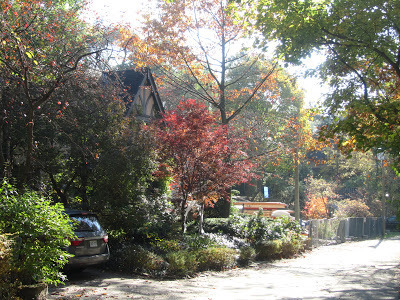 Maple leaves knee-deep in gutters. Black squirrels so shiny they look coiffed. Slashes of streets with wide-mouthed names: Jarvis, Spadina, Bloor. So much of Canada was built in an unfortunate period, 1965-1980. Hard to imagine any material suiting our dour climate less than the slush-coloured concrete popular in the Seventies. If we get rich enough, can we tear it down, and try again? My parents spent their first six months of marriage in an apartment off Avenue Road, the only time my mother ever lived away from Montreal. Their old building reminds me of a Montreal apartment house. It could be on Sherbrooke Street in Westmount. My father was transferred back to Montreal eventually. Mum always spoke of those six months as a time when she had gone bravely into exile, as if they had been sod-busting in Nebraska, say, in 1880.
Maple leaves knee-deep in gutters. Black squirrels so shiny they look coiffed. Slashes of streets with wide-mouthed names: Jarvis, Spadina, Bloor. So much of Canada was built in an unfortunate period, 1965-1980. Hard to imagine any material suiting our dour climate less than the slush-coloured concrete popular in the Seventies. If we get rich enough, can we tear it down, and try again? My parents spent their first six months of marriage in an apartment off Avenue Road, the only time my mother ever lived away from Montreal. Their old building reminds me of a Montreal apartment house. It could be on Sherbrooke Street in Westmount. My father was transferred back to Montreal eventually. Mum always spoke of those six months as a time when she had gone bravely into exile, as if they had been sod-busting in Nebraska, say, in 1880.
To my parents' generation, TO was Dullsville.... I prefer sleeping in my station wagon because I can drive as long as I want and not worry about the next town, the next motel. Two hundred kilometers northwest of Sault Ste Marie I turn into a campground that's closed for the season. I hear a rushing sound when I shut down the motor. At first I think it's wind through birches. But it isn't steady. It has a staccato rhythm. I hike over a dune and encounter Lake Superior shining under a full moon, throwing three-foot waves on a beach. I feel so exhilirated that I start yipping like a coyote. I can't sleep. The Laurentian landscape--along the river, around Georgian Bay, here on the north shore of Superior--has me stirred me up with beaverish patriotic ardor. The terrain of childhood summers--maybe it's the latitude--registers deep. Birches mixed with spruce and larch. Knobs of tough, grainy little hills and black, fast rivers. Is it the specific quality of the light that is the grabber? Do we all have default settings for home?... Two summers ago, driving from Los Angeles to New York via Alberta, I started worrying about getting fat. I didn't want to look like some long-haul truckers, belly like a cast-iron stove, bandy vestigal legs. So I began stopping at gyms, Y's, fitness centres. The best gym so far has been Toronto's gleaming Central YMCA. The worst was in Clovis, New Mexico where a pair of bikers were arguing about hair conditioner. One insisted it gave his hair body. The other said conditioner was useless. The difference of opinion was restated five or six times at increased volume until Biker#1 declared that conditioner was only useless if you use cheap shampoo. Like a forest fire jumping prepared breaks, the argument then leapt past the language skills of the antagonists, and violence loomed. I grabbed my shaving gear and got out of there.... Motel strips racket with traffic noise. I like isolated motels, deep in the country--if I’d been in Hitchcock’s Psycho I probably would have pulled in at the Bates Motel. At the Timberland Motel, in Shabaqua, Ont., the walls are thin but it doesn’t matter, there’s not much happening. It’s restful. I dislike B&B's. All that stale potpourri. Creepy miniature strawhats on the wall. I hate talking to strangers at breakfast. My favourite motel name: the Let 'er Buck, in the dusty cowtown of Pendleton, Oregon. The best highway motels are in the $30-$40 range. Paymore and you're staying at the tedious chains. Pay less and you'reslumming. Knotty pine is usually, not always, always a good sign at a motel. Clothes-lines strung along balconies are never a good sign. I'm reading Peter C. Newman's Caesars of the Wilderness, about the fur trade. As the Viennese-born, exiled, immigrant son of Jewish parents, PCN writes about Canada with understanding and unforgiving style. My edition has a cheesy, embossed cover, but feels like basic text for a cross-Canada trip. It's impossible to stand on the banks of the French River, or the shore of Superior, without imagining the canoes from Montréal paddling against the swells.
The other must-read is Jack Nisbet, Sources of the River.Was it the coureur de bois image that doomed Pierre Elliott Trudeau in the West and ultimately in Quebec? Those newspaper shots of the Prime Minister in fringed buckskin. High cheekbones, Scotch/French name. His love of rivers and skill with a paddle. He may have thought he was tapping ur-Canadian roots with this imagery, but the regime and the stay-behinds in New France, hunkered down in their parishes along the St. Lawrence, always mistrusted hommes du nord, canoe men. Did Westerners, subconsciously or not, read Trudeau as Métis, the mistrusted "half-breed"? Is that why they hated him? (Justin Trudeau, Pierre's son, hates them back, apparently). I don't recall shots of PET in a cowboy hat or poised on a combine harvester. Buckskins, cheekbones, and canoe paddles were signs of the old, miscegenating, semi-Catholic, priest-dodging, fur-trading river culture, despised by seigneurs and settlers, ad mare usque ad mare. ... The Leisure Centre & Curling Museum at Weyburn, Sask. has a dungeon-like weight room. Before pumping iron I go for a run. Streets of small, very neat nineteen-fifties and sixties bungalows. Ornamental willows and aspen stripped by the wind. Orange plastic sacks packed with leaves. Cars and pickups line the curb outside the elementary school: parents waiting for kids. Heat blasting, radios thumping. A sense of winter just over the horizon. Alex Emond photograph East of Assiniboia on Highway Thirteen, chevrons of geese in cold blue sky. I watch for twenty minutes and when I get back in the car and drive away I can still hear them honking.
Alex Emond photograph East of Assiniboia on Highway Thirteen, chevrons of geese in cold blue sky. I watch for twenty minutes and when I get back in the car and drive away I can still hear them honking.
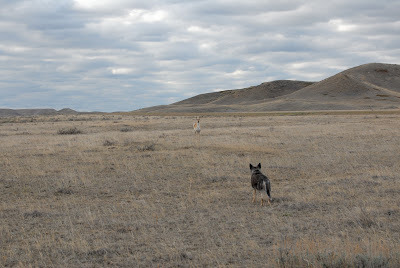 ©2012Alex Emond Cold sky of stars. I park my Volvo wagon in wheat stubble somewhere east of Cadillac, Saskatchewan and crawl into my sleeping bag as the orange moon comes up like a big fat Day-Glo tennis ball bouncing across the fields. Wind rocks the car all night, and I'm on the road before dawn. How to find a great highway cafe? Sometimes you just get lucky. The sun isn't up yet but a row of pickups and grain trucks are already angle-parked outside Jack's Café ("Since 1920") at East End. Eighteen-wheelers outside a cafe are no reliable indicator. Long-haul truckers worry about space for parking, not food. But pickups or grain trucks are a good sign. They're local. Locals know. The food is excellent. Ungreasy eggs, crisp bacon, fresh coffee. The best breakfast since Bonjour Brioche back in Toronto. No brioches, though....Road food. Macdonald's has good coffee. La Belle Province in Quebec and In-n-Out Burger in Southern California are franchises serving up excellent greasy food and a pungent sense of place. I have luck at cafes named after people who started them. Rosette's. Jack's. Nick's (Chez Nick), on Greene Avenue in Westmount. Hattie's in Saratoga Springs NY.Avoid eating within a mile of any US Interstate. Unless you see an Inn-n-Out....Chopping sage beside a creek on Hwy 501 southeast of Manyberries, Alberta. Tie up a bundle with a strand of wheat straw, throw it on the dash. Sun through the windshield, and the scent fills the car. It's slightly bitter. The smell of lemons, smell of dry wind.
©2012Alex Emond Cold sky of stars. I park my Volvo wagon in wheat stubble somewhere east of Cadillac, Saskatchewan and crawl into my sleeping bag as the orange moon comes up like a big fat Day-Glo tennis ball bouncing across the fields. Wind rocks the car all night, and I'm on the road before dawn. How to find a great highway cafe? Sometimes you just get lucky. The sun isn't up yet but a row of pickups and grain trucks are already angle-parked outside Jack's Café ("Since 1920") at East End. Eighteen-wheelers outside a cafe are no reliable indicator. Long-haul truckers worry about space for parking, not food. But pickups or grain trucks are a good sign. They're local. Locals know. The food is excellent. Ungreasy eggs, crisp bacon, fresh coffee. The best breakfast since Bonjour Brioche back in Toronto. No brioches, though....Road food. Macdonald's has good coffee. La Belle Province in Quebec and In-n-Out Burger in Southern California are franchises serving up excellent greasy food and a pungent sense of place. I have luck at cafes named after people who started them. Rosette's. Jack's. Nick's (Chez Nick), on Greene Avenue in Westmount. Hattie's in Saratoga Springs NY.Avoid eating within a mile of any US Interstate. Unless you see an Inn-n-Out....Chopping sage beside a creek on Hwy 501 southeast of Manyberries, Alberta. Tie up a bundle with a strand of wheat straw, throw it on the dash. Sun through the windshield, and the scent fills the car. It's slightly bitter. The smell of lemons, smell of dry wind.
After the hard beauty of the plains, Calgary's sprawl looks like a symptom of some torrid illness.
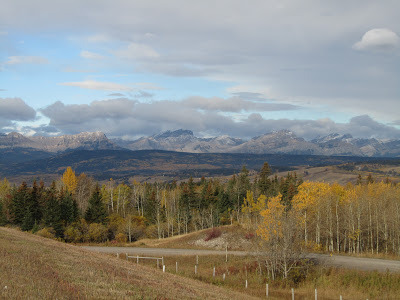
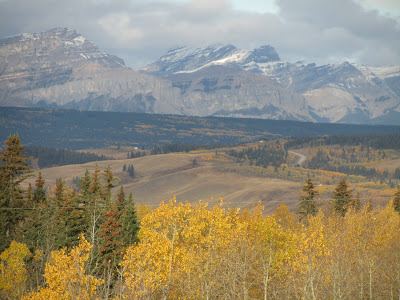 Snow in the Bow Valley. Canadians like to scorn Banff town. It's not pure enough. Maybe they want to imagine Trapper Nelson running a trading post on Banff Avenue, not Ralph Lauren selling ersatz prep-wear to the Japanese. Banff is supposed to be the enabler for Canada's wilderness fantasy, helping the rest of the nation feel better about surrendering to donut shops and malls. I like the busy streets, mild urban buzz, lack of sprawl, disrespectful elk.
Snow in the Bow Valley. Canadians like to scorn Banff town. It's not pure enough. Maybe they want to imagine Trapper Nelson running a trading post on Banff Avenue, not Ralph Lauren selling ersatz prep-wear to the Japanese. Banff is supposed to be the enabler for Canada's wilderness fantasy, helping the rest of the nation feel better about surrendering to donut shops and malls. I like the busy streets, mild urban buzz, lack of sprawl, disrespectful elk.
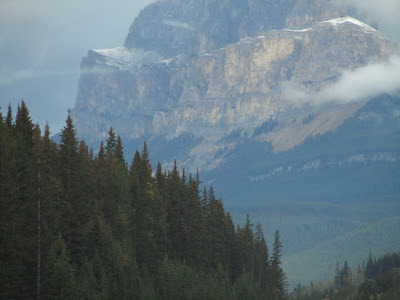
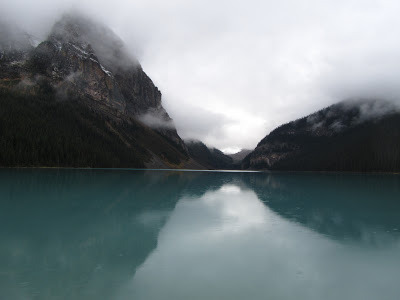 Approaching Banff, a rush of memories of our old days--hippie days--in Banff. One thing the members of that brilliant tribe had in common was passionate love of our mountains and rivers.
Approaching Banff, a rush of memories of our old days--hippie days--in Banff. One thing the members of that brilliant tribe had in common was passionate love of our mountains and rivers.
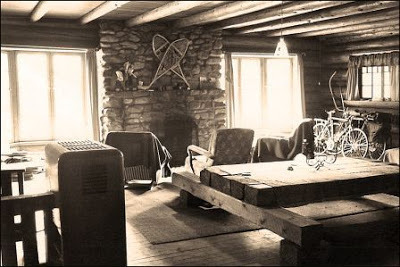 2012 JW Burleson
2012 JW Burleson
 ©2012 JW Burleson
©2012 JW Burleson
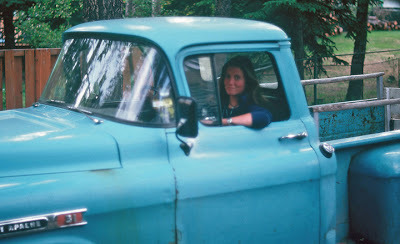 ©2012 JW Burleson
©2012 JW Burleson
 ©2012 JW Burleson
©2012 JW Burleson
 ©2012 JW Burleson
©2012 JW Burleson
 ©2012 JW Burleson Snow coming down hard on the Jasper highway. The road is solid white. Suddenly it's crazy to even think of going up over Bow Summit. I stop the car, get out. No one else on the road. Flakes the size of golf balls. When it's snowing this hard, air in the mountains smells of cold smoke.
©2012 JW Burleson Snow coming down hard on the Jasper highway. The road is solid white. Suddenly it's crazy to even think of going up over Bow Summit. I stop the car, get out. No one else on the road. Flakes the size of golf balls. When it's snowing this hard, air in the mountains smells of cold smoke.
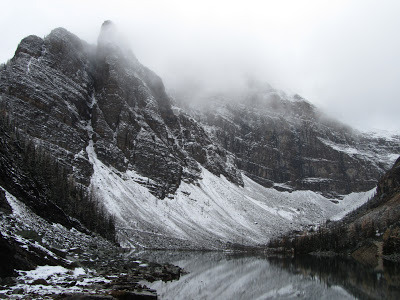 ... Plans for the Queen Charlottes are falling through, on account of winter weather in the mountains and awkward off-season ferry schedules.I wake up on my third day in Banff and can't see through snow to my car. Decide all of a sudden that I'm heading south.... On the southwestern side of the Rockies, the season has downshifted back to autumn. Cranbrook, BC gets my vote as ugliest town in Canada. Beautiful country along the Moyie River, though. The border coming up fast. I’m hoarding Canadian quarters for LA parking meters where they work just fine. [[which made sense in the days when the CDN$ was worth 80 cents US; but the last time, I checked the loony was at US$1.02--pb]]
... Plans for the Queen Charlottes are falling through, on account of winter weather in the mountains and awkward off-season ferry schedules.I wake up on my third day in Banff and can't see through snow to my car. Decide all of a sudden that I'm heading south.... On the southwestern side of the Rockies, the season has downshifted back to autumn. Cranbrook, BC gets my vote as ugliest town in Canada. Beautiful country along the Moyie River, though. The border coming up fast. I’m hoarding Canadian quarters for LA parking meters where they work just fine. [[which made sense in the days when the CDN$ was worth 80 cents US; but the last time, I checked the loony was at US$1.02--pb]]
 I'm eager to get to California, sad to leave just when my accent has sharpened back to Canadian. A country can be like your family--you feel restless as hell growing up in the middle of it but when it's gone, or you're gone, it radiates a strange power. Judy's River Bend Cafe, beside the tire-repair shop in Yahk, BC, gets my votes for best homemade borscht and best apple pie. I ask Judy if borscht means she is Doukhabor. "Nope." Back in the car. Pay attention to the country. Black clouds breaking up over the elegant Purcell Range. Bursts of sunshine, mild wind from the West Coast. Two kilometers from the Idaho border, one black moose swaggering across the road.
I'm eager to get to California, sad to leave just when my accent has sharpened back to Canadian. A country can be like your family--you feel restless as hell growing up in the middle of it but when it's gone, or you're gone, it radiates a strange power. Judy's River Bend Cafe, beside the tire-repair shop in Yahk, BC, gets my votes for best homemade borscht and best apple pie. I ask Judy if borscht means she is Doukhabor. "Nope." Back in the car. Pay attention to the country. Black clouds breaking up over the elegant Purcell Range. Bursts of sunshine, mild wind from the West Coast. Two kilometers from the Idaho border, one black moose swaggering across the road.
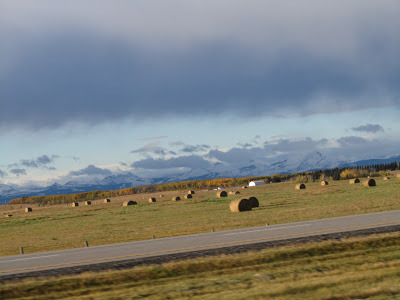

― Wallace Stegner, Angle of Repose
 ©Alex Emond 2012While I was a Stegner Fellow at Stanford I was lucky enough to meet the novelist and environmentalist Wallace Stegner, then in his eighties and an impressive man. Wally had just spent the morning cutting firewood. My introduction to his work was "Wolf Willow", the memoir of a boyhood spent in southern Saskatchewan. WS named the town where it was set Whitemud, but it is really Eastend, Sask.
©Alex Emond 2012While I was a Stegner Fellow at Stanford I was lucky enough to meet the novelist and environmentalist Wallace Stegner, then in his eighties and an impressive man. Wally had just spent the morning cutting firewood. My introduction to his work was "Wolf Willow", the memoir of a boyhood spent in southern Saskatchewan. WS named the town where it was set Whitemud, but it is really Eastend, Sask. Several years back, I drove across Canada and kept a trip log for the National Post. It was published in NP under the title, "Going the Distance" and I'm posting it, below.
On that trip I slept in my car most nights, so I could wake up in the middle of nowhere. One morning, a few miles west of nowhere, I found Jack's Cafe in Stegner's town of Eastend, Saskatchewan. A few half-tons, outside, and a few ranchers inside, and the best diner food I've ever experienced. Everything fresh. They smoked their own bacon. It seems like a dream to me now...but Alex Emond took a photo last year, so Jack's still does exist. Next time you happen to be driving across the high lonesome, time it for a breakfast stop for Eastend. And bring along your copy of Wolf Willow.
In the meantime, here's my piece--''Going the Distance"--from National Post. I do not understand why the text is posting in various fonts and sizes. It is annoying and distracting, I realize, but I can't seem to do anything about it. Apologies.
 ©2012 Mary Behrens GOING THE DISTANCEI was a restless child. When I realized that all roads in North America were connected, and that going anywhere--anywhere!-- was just a matter of taking the correct sequence of turns, I wanted to step on the gas immediately.
©2012 Mary Behrens GOING THE DISTANCEI was a restless child. When I realized that all roads in North America were connected, and that going anywhere--anywhere!-- was just a matter of taking the correct sequence of turns, I wanted to step on the gas immediately.I developed an obsession with maps, & drove across the country for the first time when I was eighteen. I've made the trip twenty times since. Now I'm piloting that indestructible symbol of middle-age, a Volvo station wagon. Flying coast-to-coast still seems like a waste of a perfectly good continent.
...
My wife likes highways but prefers frequent-flyer miles. I grew up in Montreal, live in Southern California. I'm headed home after a stay at the Fine Arts Work Center in Provincetown, Massachusetts, where I’ve been working on a novel about a boy coming out of Famine Ireland in the 1840s. It is late October and I’m invited to spend the weekend with friends at Tadoussac, Quebec. I have not been north around Lake Superior in a decade. And I miss the austere light of Saskatchewan in autumn. So I've decided to drive home across Canada....
The plan is to aim for the Queen Charlotte Islands. I can see the trip really ending there. Can't go further west in Canada. Then I'll head for California I've left it kind of late in the season, though. Anxious about snow in the mountains.
...Driving up and down the St John Valley on the Maine side, peering across the river at Canada. Small, rough hills spattered with autumn color. I feel reluctant to cross. Like a stranger standing on the porch of the house where he grew up, wary of touching the doorbell. This is disconcerting. I have never felt American. If I don't feel like I'm coming home here, crossing this border, I'm never going to.French Canadian names--Martin, Lavoie, Plourde--on all mailboxes along the last few miles of US 1. The kid at the Gulf station says the local dialect is Valley French. Across the river, "they speak more Parisian."
...
Past L'Universite de Maine á Fort-Kent I get caught in Saturday-evening-Mass traffic outside Eglise St-Louis, then finally cross the river at Edmundston. The officer at Canada Customs says Rosette's in Frenchville, Maine is the best place to eat.
...
Rosette’s is packed with families, mémère, pépère, toute la gang chowing down on broiled scallops, chowder, steaks, blueberry pie. Everyone talks fast and twangy. Sentences that start French and end English, or the other way around.
...
I'm of the Trudeaumania generation. "If you want to see me again, don't bring signs saying 'Trudeau
is a pig', and don't bring signs that 'Trudeau hustles women'
because
I won't talk to you.
I didn't get into politics to be insulted.
And don't throw wheat at me, either.
If you don't stop that,
I'll kick you right in the ass."
[PET to a young protester throwing wheat at him during a speech in Regina, (17 July 1969)]Pierre instructed us to get out there and see our country. Geography was patriotism. Maybe you remember those long lines of blackfly-baiting hitchhikers stranded out along the Trans-Canada Highway on any summer night, 1967-76?
... Sunday morning grey skies in Québec exaggerate a sense of northern bleakness. Post-Catholic countryside sports bar salons and plastic road-signs advertising danseuses, sometimes nu. The ferry from Rivière-du-Loup takes an hour and a half to cross the St. Lawrence, which is tidal and smells of the sea. Tadoussac must come close to a European fantasy of Canada. Busloads of francais de Francehave day-tripped down from Quebec City. Tiny wooden town, rough Laurentian hills, birch trees pulsing yellow.
 ©2012 Mary Behrens The sky over the estuary is stuffed with sunlight, the light of wide horizons.
©2012 Mary Behrens The sky over the estuary is stuffed with sunlight, the light of wide horizons.  ©2012 Aidan O'NeillTadoussac has a population of eight hundred or so, and twenty-eight listings in the phone book under Hovington, all with francophone first names. The forebear was a British sailor. Sixty more Hovingtons are listed in Sacre-Coeur, the next village. My friend says all the Hovingtons he knows insist they are unrelated to any others. The Europeans come to see les baleines puis les autochtones. Whales and Indians. Beluga are scarce this week, but here's one.
©2012 Aidan O'NeillTadoussac has a population of eight hundred or so, and twenty-eight listings in the phone book under Hovington, all with francophone first names. The forebear was a British sailor. Sixty more Hovingtons are listed in Sacre-Coeur, the next village. My friend says all the Hovingtons he knows insist they are unrelated to any others. The Europeans come to see les baleines puis les autochtones. Whales and Indians. Beluga are scarce this week, but here's one. Les autochtones
are scarcer. Or don't wish to perform for the Europeans. When the busloads arrive at the Cafe du Fjord, Québecois staff fake it with buckskins and face-paint.
Les autochtones
are scarcer. Or don't wish to perform for the Europeans. When the busloads arrive at the Cafe du Fjord, Québecois staff fake it with buckskins and face-paint.... Silver Mercedes Benz, parked beside a farm stand at the eastern tip of Ile d'Orleans. Cold wind blowing across fallow. Smell of black earth, apples. The Japanese couple, wearing Barbour waxed jackets, speak fractured English. The farm woman with the jolly red cheeks replies, in French, that, regretfully, she doesn't speak the language. Maybe her French sounds English to the Japanese, not fluent themselves, because they repeat in English, only louder. I catch the drift. They want to know if the maple syrup is local. She looks offended when I translate. "Bien sur monsieur, bien sur!" Stamping rubber boots, she gestures at a stand of sugar maples across the road. Smiles all around. The Japanese purchase six liters of maple syrup, two sacks of apples, and a box of maple sugar candy for two little girls waiting patiently in the Mercedes....I was often bored when I was a kid, so I loved the road's promise of freedom, speed, engagement. Now my life is more hectic. What I like most about driving now is solitude, long blank space, time to think.... It grates to hear the St Lawrence Valley and the region along the lakes called "the Windsor-Québec Corridor". It is, after all, a piece of country, not a hallway. Leaving Montréal for Toronto, I stop at Lachine to walk around the old fur trade depot, thinking of brigades of canoes forming up here each spring and paddling for Rupert's Land. It's already dark by Cornwall, and I give up on back roads, sign onto the 401. Freeways hammer gnarled mysterious country into scenery, passive and boring. I feel like a FedEx package. So I bail out of the 401 at Port Hope, Ontario. Time to slow down.

 Then it's Torontothe urbane forest.
Then it's Torontothe urbane forest.
 Maple leaves knee-deep in gutters. Black squirrels so shiny they look coiffed. Slashes of streets with wide-mouthed names: Jarvis, Spadina, Bloor. So much of Canada was built in an unfortunate period, 1965-1980. Hard to imagine any material suiting our dour climate less than the slush-coloured concrete popular in the Seventies. If we get rich enough, can we tear it down, and try again? My parents spent their first six months of marriage in an apartment off Avenue Road, the only time my mother ever lived away from Montreal. Their old building reminds me of a Montreal apartment house. It could be on Sherbrooke Street in Westmount. My father was transferred back to Montreal eventually. Mum always spoke of those six months as a time when she had gone bravely into exile, as if they had been sod-busting in Nebraska, say, in 1880.
Maple leaves knee-deep in gutters. Black squirrels so shiny they look coiffed. Slashes of streets with wide-mouthed names: Jarvis, Spadina, Bloor. So much of Canada was built in an unfortunate period, 1965-1980. Hard to imagine any material suiting our dour climate less than the slush-coloured concrete popular in the Seventies. If we get rich enough, can we tear it down, and try again? My parents spent their first six months of marriage in an apartment off Avenue Road, the only time my mother ever lived away from Montreal. Their old building reminds me of a Montreal apartment house. It could be on Sherbrooke Street in Westmount. My father was transferred back to Montreal eventually. Mum always spoke of those six months as a time when she had gone bravely into exile, as if they had been sod-busting in Nebraska, say, in 1880. To my parents' generation, TO was Dullsville.... I prefer sleeping in my station wagon because I can drive as long as I want and not worry about the next town, the next motel. Two hundred kilometers northwest of Sault Ste Marie I turn into a campground that's closed for the season. I hear a rushing sound when I shut down the motor. At first I think it's wind through birches. But it isn't steady. It has a staccato rhythm. I hike over a dune and encounter Lake Superior shining under a full moon, throwing three-foot waves on a beach. I feel so exhilirated that I start yipping like a coyote. I can't sleep. The Laurentian landscape--along the river, around Georgian Bay, here on the north shore of Superior--has me stirred me up with beaverish patriotic ardor. The terrain of childhood summers--maybe it's the latitude--registers deep. Birches mixed with spruce and larch. Knobs of tough, grainy little hills and black, fast rivers. Is it the specific quality of the light that is the grabber? Do we all have default settings for home?... Two summers ago, driving from Los Angeles to New York via Alberta, I started worrying about getting fat. I didn't want to look like some long-haul truckers, belly like a cast-iron stove, bandy vestigal legs. So I began stopping at gyms, Y's, fitness centres. The best gym so far has been Toronto's gleaming Central YMCA. The worst was in Clovis, New Mexico where a pair of bikers were arguing about hair conditioner. One insisted it gave his hair body. The other said conditioner was useless. The difference of opinion was restated five or six times at increased volume until Biker#1 declared that conditioner was only useless if you use cheap shampoo. Like a forest fire jumping prepared breaks, the argument then leapt past the language skills of the antagonists, and violence loomed. I grabbed my shaving gear and got out of there.... Motel strips racket with traffic noise. I like isolated motels, deep in the country--if I’d been in Hitchcock’s Psycho I probably would have pulled in at the Bates Motel. At the Timberland Motel, in Shabaqua, Ont., the walls are thin but it doesn’t matter, there’s not much happening. It’s restful. I dislike B&B's. All that stale potpourri. Creepy miniature strawhats on the wall. I hate talking to strangers at breakfast. My favourite motel name: the Let 'er Buck, in the dusty cowtown of Pendleton, Oregon. The best highway motels are in the $30-$40 range. Paymore and you're staying at the tedious chains. Pay less and you'reslumming. Knotty pine is usually, not always, always a good sign at a motel. Clothes-lines strung along balconies are never a good sign. I'm reading Peter C. Newman's Caesars of the Wilderness, about the fur trade. As the Viennese-born, exiled, immigrant son of Jewish parents, PCN writes about Canada with understanding and unforgiving style. My edition has a cheesy, embossed cover, but feels like basic text for a cross-Canada trip. It's impossible to stand on the banks of the French River, or the shore of Superior, without imagining the canoes from Montréal paddling against the swells.
The other must-read is Jack Nisbet, Sources of the River.Was it the coureur de bois image that doomed Pierre Elliott Trudeau in the West and ultimately in Quebec? Those newspaper shots of the Prime Minister in fringed buckskin. High cheekbones, Scotch/French name. His love of rivers and skill with a paddle. He may have thought he was tapping ur-Canadian roots with this imagery, but the regime and the stay-behinds in New France, hunkered down in their parishes along the St. Lawrence, always mistrusted hommes du nord, canoe men. Did Westerners, subconsciously or not, read Trudeau as Métis, the mistrusted "half-breed"? Is that why they hated him? (Justin Trudeau, Pierre's son, hates them back, apparently). I don't recall shots of PET in a cowboy hat or poised on a combine harvester. Buckskins, cheekbones, and canoe paddles were signs of the old, miscegenating, semi-Catholic, priest-dodging, fur-trading river culture, despised by seigneurs and settlers, ad mare usque ad mare. ... The Leisure Centre & Curling Museum at Weyburn, Sask. has a dungeon-like weight room. Before pumping iron I go for a run. Streets of small, very neat nineteen-fifties and sixties bungalows. Ornamental willows and aspen stripped by the wind. Orange plastic sacks packed with leaves. Cars and pickups line the curb outside the elementary school: parents waiting for kids. Heat blasting, radios thumping. A sense of winter just over the horizon.
 Alex Emond photograph East of Assiniboia on Highway Thirteen, chevrons of geese in cold blue sky. I watch for twenty minutes and when I get back in the car and drive away I can still hear them honking.
Alex Emond photograph East of Assiniboia on Highway Thirteen, chevrons of geese in cold blue sky. I watch for twenty minutes and when I get back in the car and drive away I can still hear them honking.
 ©2012Alex Emond Cold sky of stars. I park my Volvo wagon in wheat stubble somewhere east of Cadillac, Saskatchewan and crawl into my sleeping bag as the orange moon comes up like a big fat Day-Glo tennis ball bouncing across the fields. Wind rocks the car all night, and I'm on the road before dawn. How to find a great highway cafe? Sometimes you just get lucky. The sun isn't up yet but a row of pickups and grain trucks are already angle-parked outside Jack's Café ("Since 1920") at East End. Eighteen-wheelers outside a cafe are no reliable indicator. Long-haul truckers worry about space for parking, not food. But pickups or grain trucks are a good sign. They're local. Locals know. The food is excellent. Ungreasy eggs, crisp bacon, fresh coffee. The best breakfast since Bonjour Brioche back in Toronto. No brioches, though....Road food. Macdonald's has good coffee. La Belle Province in Quebec and In-n-Out Burger in Southern California are franchises serving up excellent greasy food and a pungent sense of place. I have luck at cafes named after people who started them. Rosette's. Jack's. Nick's (Chez Nick), on Greene Avenue in Westmount. Hattie's in Saratoga Springs NY.Avoid eating within a mile of any US Interstate. Unless you see an Inn-n-Out....Chopping sage beside a creek on Hwy 501 southeast of Manyberries, Alberta. Tie up a bundle with a strand of wheat straw, throw it on the dash. Sun through the windshield, and the scent fills the car. It's slightly bitter. The smell of lemons, smell of dry wind.
©2012Alex Emond Cold sky of stars. I park my Volvo wagon in wheat stubble somewhere east of Cadillac, Saskatchewan and crawl into my sleeping bag as the orange moon comes up like a big fat Day-Glo tennis ball bouncing across the fields. Wind rocks the car all night, and I'm on the road before dawn. How to find a great highway cafe? Sometimes you just get lucky. The sun isn't up yet but a row of pickups and grain trucks are already angle-parked outside Jack's Café ("Since 1920") at East End. Eighteen-wheelers outside a cafe are no reliable indicator. Long-haul truckers worry about space for parking, not food. But pickups or grain trucks are a good sign. They're local. Locals know. The food is excellent. Ungreasy eggs, crisp bacon, fresh coffee. The best breakfast since Bonjour Brioche back in Toronto. No brioches, though....Road food. Macdonald's has good coffee. La Belle Province in Quebec and In-n-Out Burger in Southern California are franchises serving up excellent greasy food and a pungent sense of place. I have luck at cafes named after people who started them. Rosette's. Jack's. Nick's (Chez Nick), on Greene Avenue in Westmount. Hattie's in Saratoga Springs NY.Avoid eating within a mile of any US Interstate. Unless you see an Inn-n-Out....Chopping sage beside a creek on Hwy 501 southeast of Manyberries, Alberta. Tie up a bundle with a strand of wheat straw, throw it on the dash. Sun through the windshield, and the scent fills the car. It's slightly bitter. The smell of lemons, smell of dry wind.After the hard beauty of the plains, Calgary's sprawl looks like a symptom of some torrid illness.

 Snow in the Bow Valley. Canadians like to scorn Banff town. It's not pure enough. Maybe they want to imagine Trapper Nelson running a trading post on Banff Avenue, not Ralph Lauren selling ersatz prep-wear to the Japanese. Banff is supposed to be the enabler for Canada's wilderness fantasy, helping the rest of the nation feel better about surrendering to donut shops and malls. I like the busy streets, mild urban buzz, lack of sprawl, disrespectful elk.
Snow in the Bow Valley. Canadians like to scorn Banff town. It's not pure enough. Maybe they want to imagine Trapper Nelson running a trading post on Banff Avenue, not Ralph Lauren selling ersatz prep-wear to the Japanese. Banff is supposed to be the enabler for Canada's wilderness fantasy, helping the rest of the nation feel better about surrendering to donut shops and malls. I like the busy streets, mild urban buzz, lack of sprawl, disrespectful elk.

 Approaching Banff, a rush of memories of our old days--hippie days--in Banff. One thing the members of that brilliant tribe had in common was passionate love of our mountains and rivers.
Approaching Banff, a rush of memories of our old days--hippie days--in Banff. One thing the members of that brilliant tribe had in common was passionate love of our mountains and rivers. 2012 JW Burleson
2012 JW Burleson
 ©2012 JW Burleson
©2012 JW Burleson
 ©2012 JW Burleson
©2012 JW Burleson
 ©2012 JW Burleson
©2012 JW Burleson
 ©2012 JW Burleson
©2012 JW Burleson
 ©2012 JW Burleson Snow coming down hard on the Jasper highway. The road is solid white. Suddenly it's crazy to even think of going up over Bow Summit. I stop the car, get out. No one else on the road. Flakes the size of golf balls. When it's snowing this hard, air in the mountains smells of cold smoke.
©2012 JW Burleson Snow coming down hard on the Jasper highway. The road is solid white. Suddenly it's crazy to even think of going up over Bow Summit. I stop the car, get out. No one else on the road. Flakes the size of golf balls. When it's snowing this hard, air in the mountains smells of cold smoke. ... Plans for the Queen Charlottes are falling through, on account of winter weather in the mountains and awkward off-season ferry schedules.I wake up on my third day in Banff and can't see through snow to my car. Decide all of a sudden that I'm heading south.... On the southwestern side of the Rockies, the season has downshifted back to autumn. Cranbrook, BC gets my vote as ugliest town in Canada. Beautiful country along the Moyie River, though. The border coming up fast. I’m hoarding Canadian quarters for LA parking meters where they work just fine. [[which made sense in the days when the CDN$ was worth 80 cents US; but the last time, I checked the loony was at US$1.02--pb]]
... Plans for the Queen Charlottes are falling through, on account of winter weather in the mountains and awkward off-season ferry schedules.I wake up on my third day in Banff and can't see through snow to my car. Decide all of a sudden that I'm heading south.... On the southwestern side of the Rockies, the season has downshifted back to autumn. Cranbrook, BC gets my vote as ugliest town in Canada. Beautiful country along the Moyie River, though. The border coming up fast. I’m hoarding Canadian quarters for LA parking meters where they work just fine. [[which made sense in the days when the CDN$ was worth 80 cents US; but the last time, I checked the loony was at US$1.02--pb]] I'm eager to get to California, sad to leave just when my accent has sharpened back to Canadian. A country can be like your family--you feel restless as hell growing up in the middle of it but when it's gone, or you're gone, it radiates a strange power. Judy's River Bend Cafe, beside the tire-repair shop in Yahk, BC, gets my votes for best homemade borscht and best apple pie. I ask Judy if borscht means she is Doukhabor. "Nope." Back in the car. Pay attention to the country. Black clouds breaking up over the elegant Purcell Range. Bursts of sunshine, mild wind from the West Coast. Two kilometers from the Idaho border, one black moose swaggering across the road.
I'm eager to get to California, sad to leave just when my accent has sharpened back to Canadian. A country can be like your family--you feel restless as hell growing up in the middle of it but when it's gone, or you're gone, it radiates a strange power. Judy's River Bend Cafe, beside the tire-repair shop in Yahk, BC, gets my votes for best homemade borscht and best apple pie. I ask Judy if borscht means she is Doukhabor. "Nope." Back in the car. Pay attention to the country. Black clouds breaking up over the elegant Purcell Range. Bursts of sunshine, mild wind from the West Coast. Two kilometers from the Idaho border, one black moose swaggering across the road.
Published on December 16, 2012 22:29
Amsterdam bikes: omafiets & opafiets
Walking around Amsterdam oud-west and realized once again that densely populated older city centers are poor places to scout old trucks. It was time to try for a photo essay on that wonderful thing, the Dutch vernacular bicycle.

Above, the machine in its purest form: the omafiets, ("granny's bike")the classic sit-up-and-beg Netherlands roadster bike. (The men's version, with a diamond frame, is opafiets; this type are also known as stadtsfiets ("city bikes")Clean and simple lines, no gearing needed since the whole country is flat, no fancy gew-gaws since bike theft is common and no one in oud-westwould ever think of carrying their bike up 4 flights of stairs to their flat. Amsterdam bikes are street creatures: battered and bruised and rain-soaked, also reliable, quick, and cheap, and the best way of getting around this city.

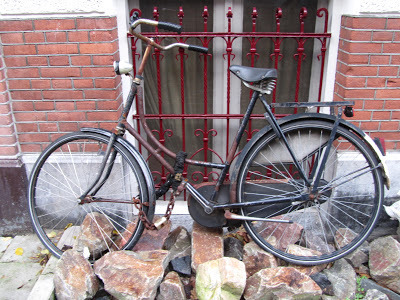
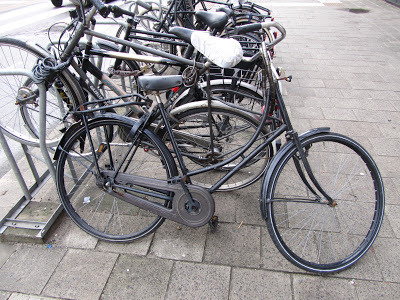


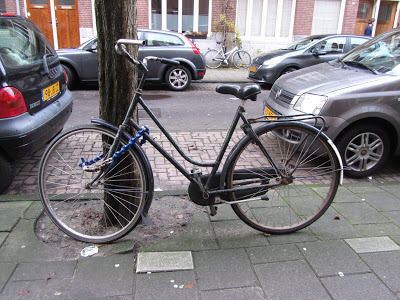

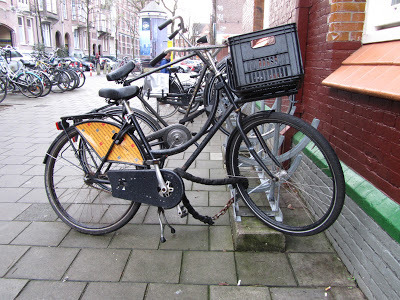



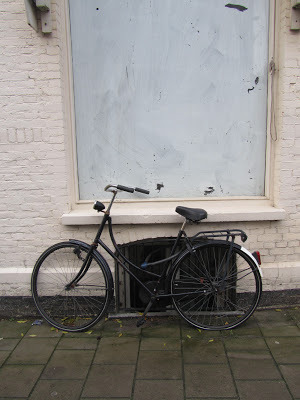 We have been living on our bikes since we got here in August and will be sorry to give them up.
We have been living on our bikes since we got here in August and will be sorry to give them up.

Above, the machine in its purest form: the omafiets, ("granny's bike")the classic sit-up-and-beg Netherlands roadster bike. (The men's version, with a diamond frame, is opafiets; this type are also known as stadtsfiets ("city bikes")Clean and simple lines, no gearing needed since the whole country is flat, no fancy gew-gaws since bike theft is common and no one in oud-westwould ever think of carrying their bike up 4 flights of stairs to their flat. Amsterdam bikes are street creatures: battered and bruised and rain-soaked, also reliable, quick, and cheap, and the best way of getting around this city.











 We have been living on our bikes since we got here in August and will be sorry to give them up.
We have been living on our bikes since we got here in August and will be sorry to give them up.
Published on December 16, 2012 11:32
December 15, 2012
Marfa Sky
Published on December 15, 2012 05:46
December 12, 2012
The Burlesons, New Mexico, and David Byrne
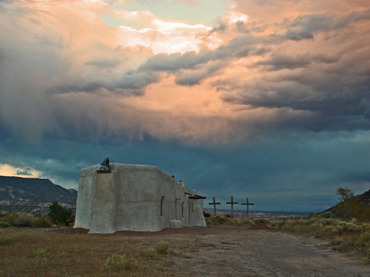 Bill Burleson, native Texan, part-Californian, semi-Canadian, has been in a love/hate relationship with N Mex for the last twenty years. His camera eye delivers judicious often brilliant perspectives on The Land of Enchantment. (all images ©JW Burleson 2012)
Bill Burleson, native Texan, part-Californian, semi-Canadian, has been in a love/hate relationship with N Mex for the last twenty years. His camera eye delivers judicious often brilliant perspectives on The Land of Enchantment. (all images ©JW Burleson 2012)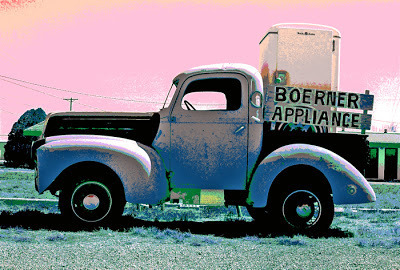

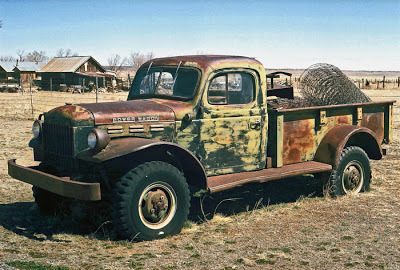

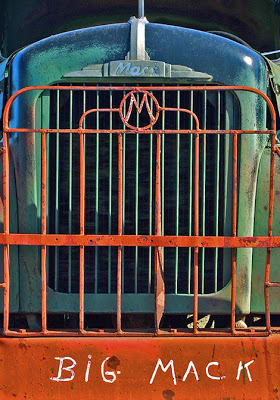
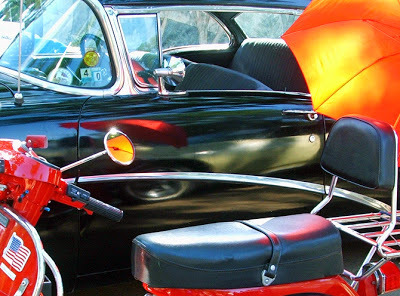
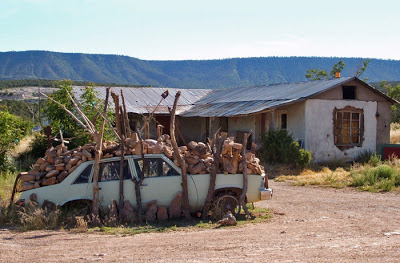
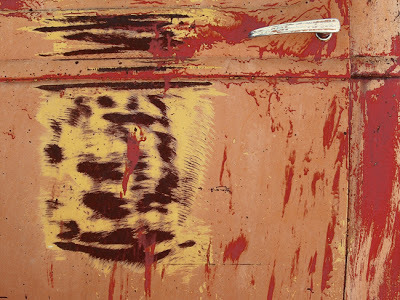

 Meanwhile David Byrne has been collecting the work of Bill's father, legendary outsider TM Burleson.
Meanwhile David Byrne has been collecting the work of Bill's father, legendary outsider TM Burleson.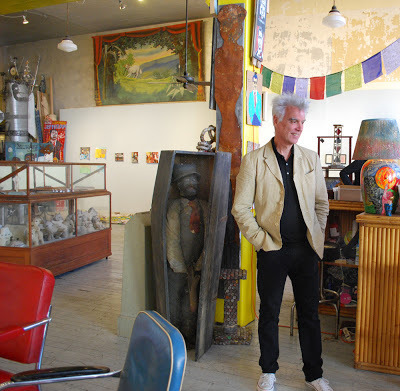
Published on December 12, 2012 00:48
December 11, 2012
1954 Ford Crestline Victoria, original
from Michael S Moore, in Northern California: (the car belongs to a neighbor):"A month or so ago he told me he'd found this Craigslist Ford, and a bit of its story; turns out the car was bought new by a woman in Martinez, CA who shipped it to Europe [not sure when but probably shortly thereafter] for a grand tour, then brought it home where it stayed, always garaged. When she passed away a neighbor kid got ahold of it, took it to a local mechanic to fix and then couldn't pay the bill...at which point it went up for sale and my buddy spotted it, cut a deal to buy it in good running condition [which it wasn't, though nothing horrible - fuel system, brakes, battery, tires] and subsequently drove it home, where I just saw it. 1954 Ford Crestline; hadn't been registered since '91. Sounds solid! OHV V-8, overdrive, tinted glass and all the original trimmings. Red motor, yellow [and white] exterior; blue interior - primary colors! Anyway, he's happy as a duck, fussing around with the thing, and the second registered owner."--MSM
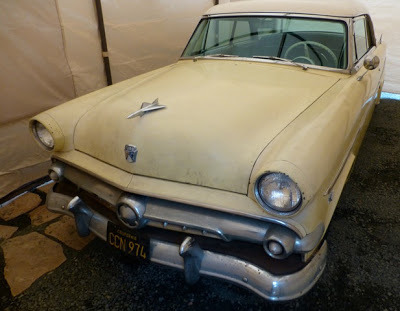
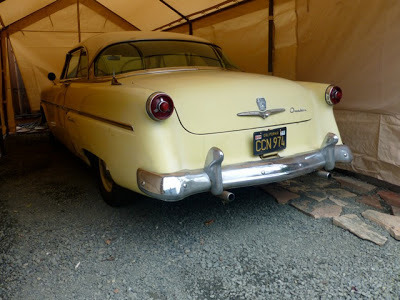
Published on December 11, 2012 11:36
1952 Chevrolet Truck & Saskatchewan Wheat Pool
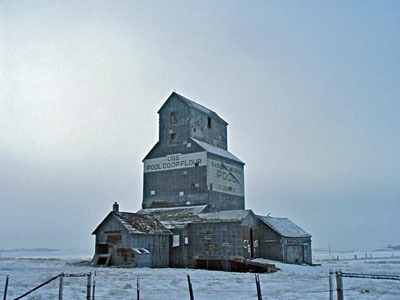
Alex Emond, our man in the prairie provinces, found this 1952 Chevrolet grainer last summer in southern Saskatchewan, Canada's national wildlife preserve for old trucks, and home of the first (1944) democratic socialist government in North America.
The '52 Chevy grainer we drove from Banff to the Rio Grande looks like the same truck. A lot of the grainers lasted a long time because they were used infrequently---hauling grain to the bins at harvest time, or to the Saskatchewan Wheat Pool elevators in town.

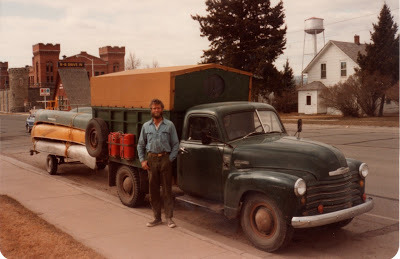
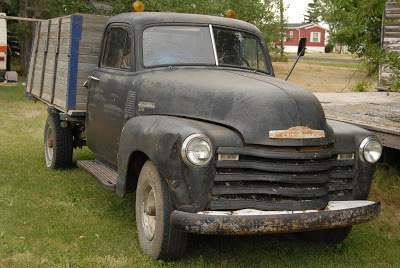


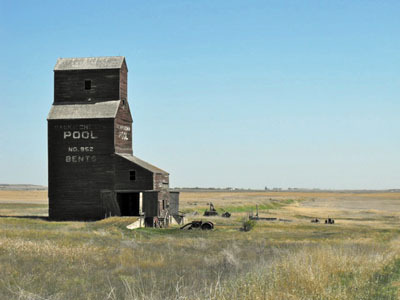
Published on December 11, 2012 01:34
Can You Compost a VW Bus?
From Michael S Moore at a hippy graveyard in southern Colorado, last summer:



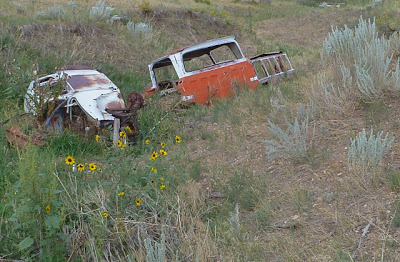
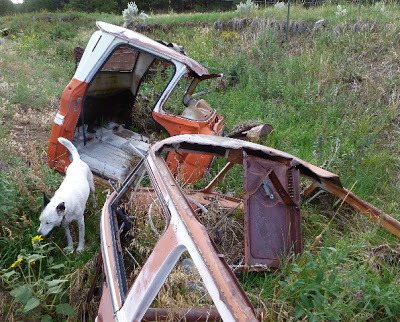
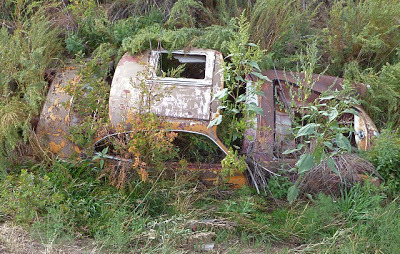
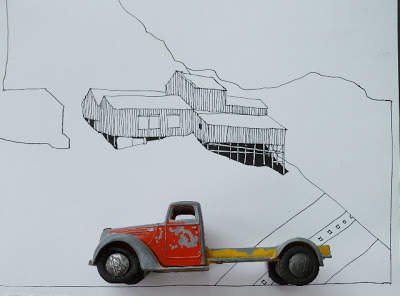 "This little collection is on the lower border of the land where we are here in southern Colorado, an artists' community founded in the late sixties, which veered toward "commune" in the seventies and is now nominally back to original intentions. Tossing vehicles into arroyos as erosion control is a common tactic throughout the southwest, but the derelicts in this particular landfill definitely speak to the era...VW bug, early 60's Chevy pickup cab, VW bus..."--MSM
"This little collection is on the lower border of the land where we are here in southern Colorado, an artists' community founded in the late sixties, which veered toward "commune" in the seventies and is now nominally back to original intentions. Tossing vehicles into arroyos as erosion control is a common tactic throughout the southwest, but the derelicts in this particular landfill definitely speak to the era...VW bug, early 60's Chevy pickup cab, VW bus..."--MSM






 "This little collection is on the lower border of the land where we are here in southern Colorado, an artists' community founded in the late sixties, which veered toward "commune" in the seventies and is now nominally back to original intentions. Tossing vehicles into arroyos as erosion control is a common tactic throughout the southwest, but the derelicts in this particular landfill definitely speak to the era...VW bug, early 60's Chevy pickup cab, VW bus..."--MSM
"This little collection is on the lower border of the land where we are here in southern Colorado, an artists' community founded in the late sixties, which veered toward "commune" in the seventies and is now nominally back to original intentions. Tossing vehicles into arroyos as erosion control is a common tactic throughout the southwest, but the derelicts in this particular landfill definitely speak to the era...VW bug, early 60's Chevy pickup cab, VW bus..."--MSM
Published on December 11, 2012 01:26
December 9, 2012
Montreal, Robert Benchley, Kenneth Tynan
I've been reading the copyedit of my book of stories, Travelling Light, (Canadian spelling, eh?) due out this summer from Anansi, so I'm thinking a lot about Montreal these days--my hometown, and the setting of some of the stories. For no better reason than that, I'm posting Montreal (et ses environs) photos--mostly by me, a few from the family archive. The first person who can identify tous les endroits wins....a 1st edition of Travelling Light, signe par moi. For anyone interested in Montreal, Kristian Gravenor's blog coolopolis is huge fun. It's wry & pithy & intelligent & very knowing about Montreal, a city which has, god knows, inspired much bad writing & weak thinking. Not to mention way too much European-style clowning.* And if you're aiming for Montreal anytime soon, or just want to keep an eye on what's happening there in the arts, The Rover's weekly The List is essential.
C'est pas facile d'être amoureux à Montréal
Le ciel est bas, la terre est grise, le fleuve est sale
Le Mont-Royal est mal à l'aise, y a l'air de trop
Westmount le tient serré dans un étau
Y a des quartiers où le monde veille sur le perron
Y a un bonhomme qui en a fait une belle chanson
Dans ces bouts-là les jeunes se tiennent au fond des cours
Y prennent un coke, y prennent une bière, y font l'amour Forget Paris. The city that Montreal most resembles--in its history as a 19th c. low-wage factory town, its ethnicities, architecture, huge number of churches, self-regarding neighbourhods, and urban style, is Brooklyn NY.
Of course Brooklyn has Manhattan across the river, and Montreal has Longeuil.

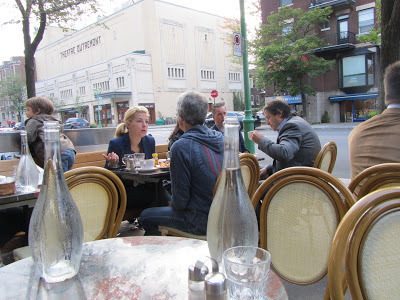

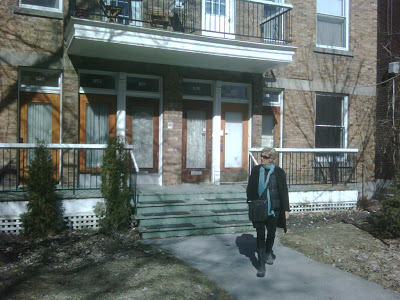
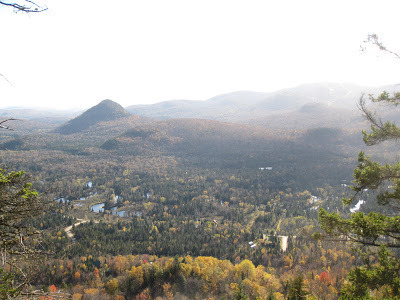
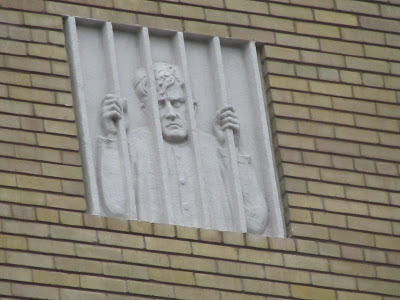
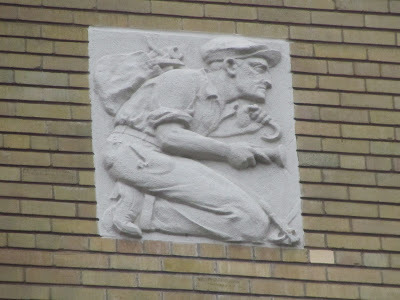
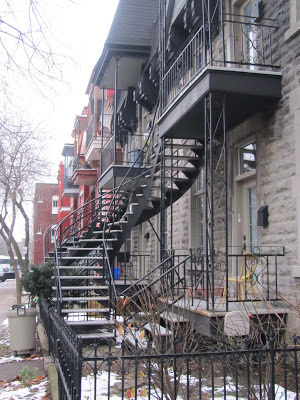
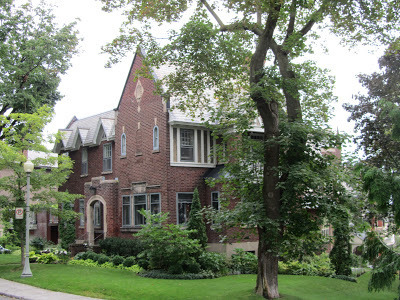

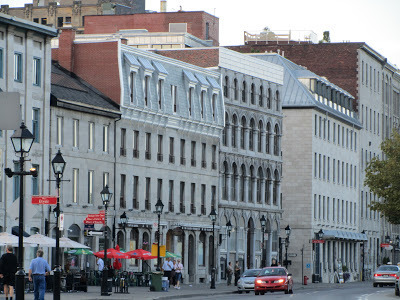
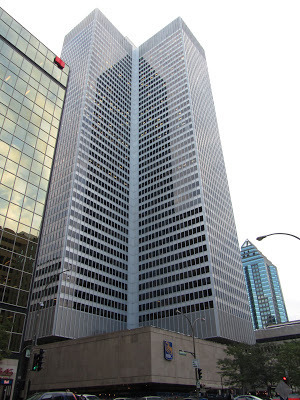

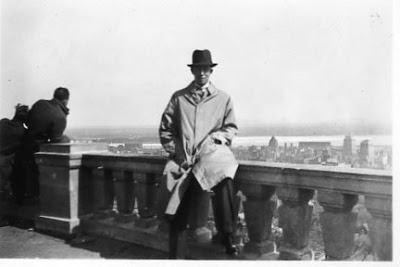
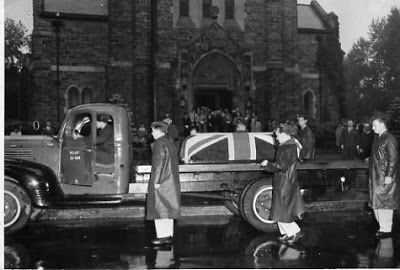
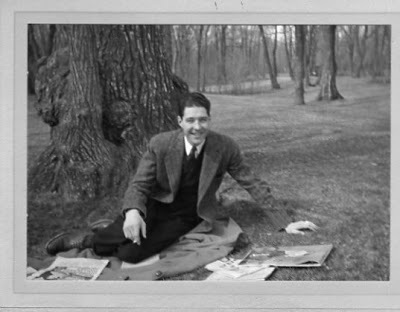
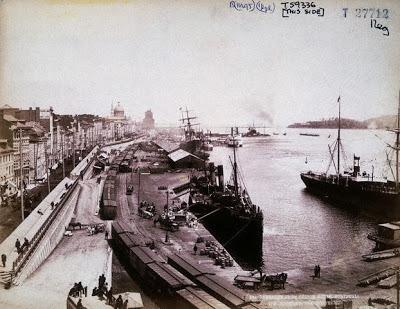
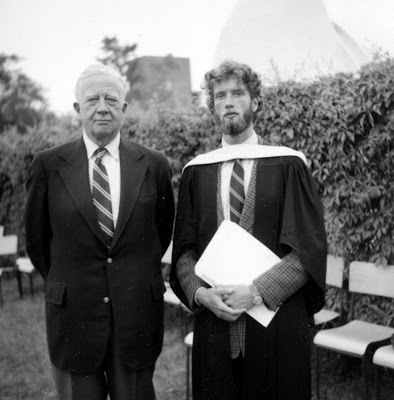

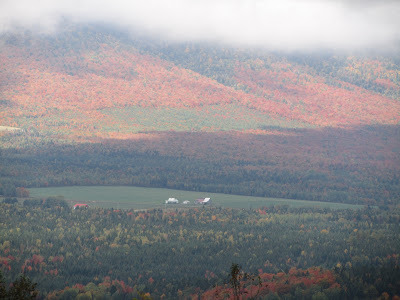

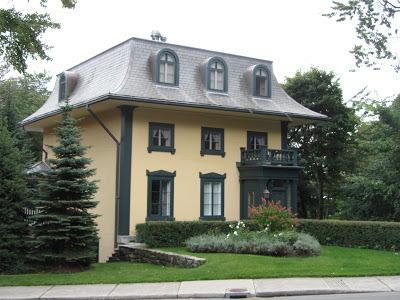

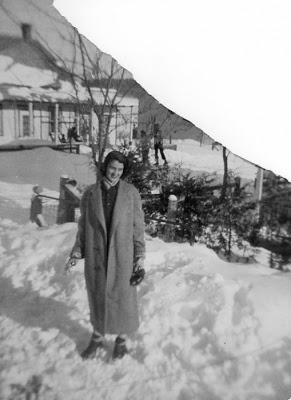
*A French clown, according to the late Robert Benchley, is the superlative form of the adjective "unfunny." One knows what he meant. You have only to utter the phrase and I see a milk-faced, red-nosed, popeyed oaf (later to be described as a 'Chaplinesque droll') falling backward off a kitchen chair while in the act of blowing low C on a slide trombone. Behind him, doubled up with laughter, crouches his partner, or deuxiéme banane, who wear spangles and carries in one hand a soprano saxophone. They are both, you understand, brilliant musicians; only brilliant musicians could pretend to play so badly. They are in the great line of Continental clowns, and that, as far as Mr. Benchley and I are concerned, means the firing line.-- Kenneth Tynan, 1960

C'est pas facile d'être amoureux à Montréal
Le ciel est bas, la terre est grise, le fleuve est sale
Le Mont-Royal est mal à l'aise, y a l'air de trop
Westmount le tient serré dans un étau
Y a des quartiers où le monde veille sur le perron
Y a un bonhomme qui en a fait une belle chanson
Dans ces bouts-là les jeunes se tiennent au fond des cours
Y prennent un coke, y prennent une bière, y font l'amour Forget Paris. The city that Montreal most resembles--in its history as a 19th c. low-wage factory town, its ethnicities, architecture, huge number of churches, self-regarding neighbourhods, and urban style, is Brooklyn NY.
Of course Brooklyn has Manhattan across the river, and Montreal has Longeuil.
























*A French clown, according to the late Robert Benchley, is the superlative form of the adjective "unfunny." One knows what he meant. You have only to utter the phrase and I see a milk-faced, red-nosed, popeyed oaf (later to be described as a 'Chaplinesque droll') falling backward off a kitchen chair while in the act of blowing low C on a slide trombone. Behind him, doubled up with laughter, crouches his partner, or deuxiéme banane, who wear spangles and carries in one hand a soprano saxophone. They are both, you understand, brilliant musicians; only brilliant musicians could pretend to play so badly. They are in the great line of Continental clowns, and that, as far as Mr. Benchley and I are concerned, means the firing line.-- Kenneth Tynan, 1960
Published on December 09, 2012 00:36
December 8, 2012
Tesla Model S: "This Is The Future I Want"
This from our man in Chapel Hill, Lee Buck, who recently took delivery of his Tesla Model S

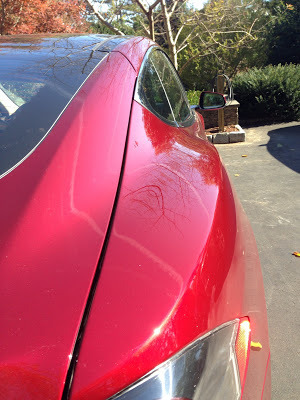
"Yesterday I fueled my car for the last time. With luck it may be the last time I ever put fuel into a car. Today I took delivery of a Tesla Model S.
"What first strikes you when you drive the Model S is the silence. As you pull away from the curb, the total absence of noise seems wrong. Your brain clicks into alert mode trying to figure out the conflicting signals: motion is supposed to be noisy.
"As you maneuver around the parking lot, your brain is confronted by another paradox. The car feels solid and purposeful — befitting its substantial size and weight — but also deft and effortless. The smooth and linear responses to your inputs instills a sense of confidence and wonder.
"Take it out into the open road and punch the accelerator. You rush forward with an immediacy and urgency that you didn't know was possible. Your right foot seems connected directly to the small of your back. Press hard and your back instantly knows what your ears disbelieve. The dashboard digits blur while the g-forces command your lips into a grin. No sound, no fury, no smoke, no drama. Just bewildering acceleration — so this is what it feels like to be the pellet in the slingshot...
"Find a winding road and you can reinterpret the laws of physics. With its weight mostly below your feet, it hugs the road like a race car. No leaning, no slipping, no squealing. Just a connection to the road like the slots cars of your youth.
"Ease back and settle in for the daily commute. The interior is clean and calm. The large screen is prominent but not distracting. Its UI is smart and beautiful — finally a car computer that complements rather than detracts.
"And then it hits you: this is an incredible car… one of the finest in the world. It doesn't need its own category, it doesn't need to be graded on a curve. It beats a century of internal combustion engine technology on its first at-bat.
"This is the future of my youth. This is the future that I want. No more toxic fuels and poisonous emissions. No more underwriting sheiks and fighting wars. It is said that you have two important votes in life: one at the polling place and one at the cash register. I made my vote. I am an official sponsor of the future."
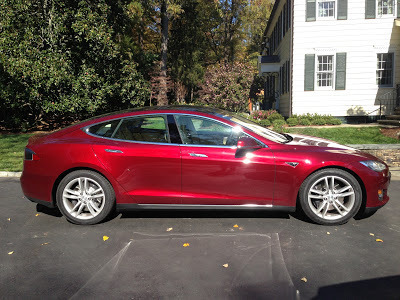



"Yesterday I fueled my car for the last time. With luck it may be the last time I ever put fuel into a car. Today I took delivery of a Tesla Model S.
"What first strikes you when you drive the Model S is the silence. As you pull away from the curb, the total absence of noise seems wrong. Your brain clicks into alert mode trying to figure out the conflicting signals: motion is supposed to be noisy.
"As you maneuver around the parking lot, your brain is confronted by another paradox. The car feels solid and purposeful — befitting its substantial size and weight — but also deft and effortless. The smooth and linear responses to your inputs instills a sense of confidence and wonder.
"Take it out into the open road and punch the accelerator. You rush forward with an immediacy and urgency that you didn't know was possible. Your right foot seems connected directly to the small of your back. Press hard and your back instantly knows what your ears disbelieve. The dashboard digits blur while the g-forces command your lips into a grin. No sound, no fury, no smoke, no drama. Just bewildering acceleration — so this is what it feels like to be the pellet in the slingshot...
"Find a winding road and you can reinterpret the laws of physics. With its weight mostly below your feet, it hugs the road like a race car. No leaning, no slipping, no squealing. Just a connection to the road like the slots cars of your youth.
"Ease back and settle in for the daily commute. The interior is clean and calm. The large screen is prominent but not distracting. Its UI is smart and beautiful — finally a car computer that complements rather than detracts.
"And then it hits you: this is an incredible car… one of the finest in the world. It doesn't need its own category, it doesn't need to be graded on a curve. It beats a century of internal combustion engine technology on its first at-bat.
"This is the future of my youth. This is the future that I want. No more toxic fuels and poisonous emissions. No more underwriting sheiks and fighting wars. It is said that you have two important votes in life: one at the polling place and one at the cash register. I made my vote. I am an official sponsor of the future."

Published on December 08, 2012 11:01

